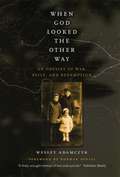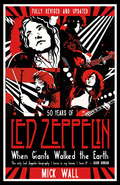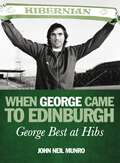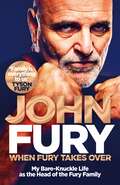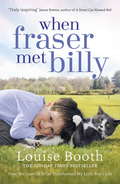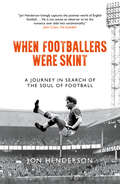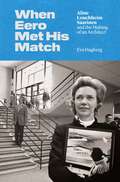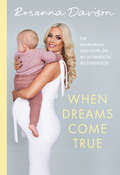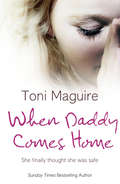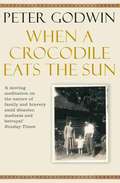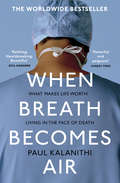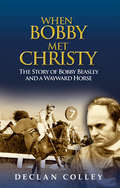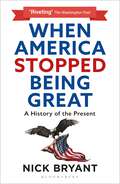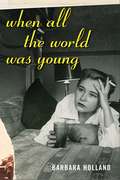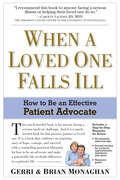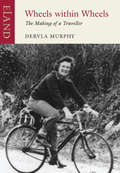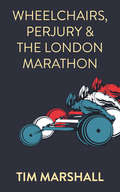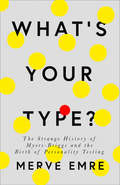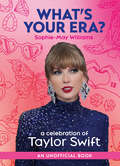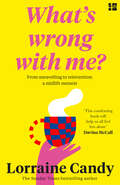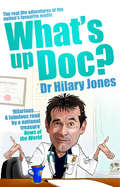- Table View
- List View
When God Looked the Other Way: An Odyssey of War, Exile, and Redemption (Nber - Macroeconomics Annual Ser.)
by Wesley AdamczykOften overlooked in accounts of World War II is the Soviet Union's quiet yet brutal campaign against Polish citizens, a campaign that included, we now know, war crimes for which the Soviet and Russian governments only recently admitted culpability. Standing in the shadow of the Holocaust, this episode of European history is often overlooked. Wesley Adamczyk's gripping memoir, When God Looked the Other Way, now gives voice to the hundreds of thousands of victims of Soviet barbarism. Adamczyk was a young Polish boy when he was deported with his mother and siblings from their comfortable home in Luck to Soviet Siberia in May of 1940. His father, a Polish Army officer, was taken prisoner by the Red Army and eventually became one of the victims of the Katyn massacre, in which tens of thousands of Polish officers were slain at the hands of the Soviet secret police. The family's separation and deportation in 1940 marked the beginning of a ten-year odyssey in which the family endured fierce living conditions, meager food rations, chronic displacement, and rampant disease, first in the Soviet Union and then in Iran, where Adamczyk's mother succumbed to exhaustion after mounting a harrowing escape from the Soviets. Wandering from country to country and living in refugee camps and the homes of strangers, Adamczyk struggled to survive and maintain his dignity amid the horrors of war. When God Looked the Other Way is a memoir of a boyhood lived in unspeakable circumstances, a book that not only illuminates one of the darkest periods of European history but also traces the loss of innocence and the fight against despair that took root in one young boy. It is also a book that offers a stark picture of the unforgiving nature of Communism and its champions. Unflinching and poignant, When God Looked the Other Way will stand as a testament to the trials of a family during wartime and an intimate chronicle of episodes yet to receive their historical due. “Adamczyk recounts the story of his own wartime childhood with exemplary precision and immense emotional sensitivity, presenting the ordeal of one family with the clarity and insight of a skilled novelist. . . . I have read many descriptions of the Siberian odyssey and of other forgotten wartime episodes. But none of them is more informative, more moving, or more beautifully written than When God Looked the Other Way.”—From the Foreword by Norman Davies, author of Europe: A History and Rising ’44: The Battle for Warsaw “A finely wrought memoir of loss and survival.”—Publishers Weekly “Adamczyk’s unpretentious prose is well-suited to capture that truly awful reality.” —Andrew Wachtel, Chicago Tribune Books “Mr. Adamczyk writes heartfelt, straightforward prose. . . . This book sheds light on more than one forgotten episode of history.”—Gordon Haber, New York Sun “One of the most remarkable World War II sagas I have ever read. It is history with a human face.”—Andrew Beichman, Washington Times
When God Looked the Other Way: An Odyssey of War, Exile, and Redemption
by Wesley AdamczykOften overlooked in accounts of World War II is the Soviet Union's quiet yet brutal campaign against Polish citizens, a campaign that included, we now know, war crimes for which the Soviet and Russian governments only recently admitted culpability. Standing in the shadow of the Holocaust, this episode of European history is often overlooked. Wesley Adamczyk's gripping memoir, When God Looked the Other Way, now gives voice to the hundreds of thousands of victims of Soviet barbarism. Adamczyk was a young Polish boy when he was deported with his mother and siblings from their comfortable home in Luck to Soviet Siberia in May of 1940. His father, a Polish Army officer, was taken prisoner by the Red Army and eventually became one of the victims of the Katyn massacre, in which tens of thousands of Polish officers were slain at the hands of the Soviet secret police. The family's separation and deportation in 1940 marked the beginning of a ten-year odyssey in which the family endured fierce living conditions, meager food rations, chronic displacement, and rampant disease, first in the Soviet Union and then in Iran, where Adamczyk's mother succumbed to exhaustion after mounting a harrowing escape from the Soviets. Wandering from country to country and living in refugee camps and the homes of strangers, Adamczyk struggled to survive and maintain his dignity amid the horrors of war. When God Looked the Other Way is a memoir of a boyhood lived in unspeakable circumstances, a book that not only illuminates one of the darkest periods of European history but also traces the loss of innocence and the fight against despair that took root in one young boy. It is also a book that offers a stark picture of the unforgiving nature of Communism and its champions. Unflinching and poignant, When God Looked the Other Way will stand as a testament to the trials of a family during wartime and an intimate chronicle of episodes yet to receive their historical due. “Adamczyk recounts the story of his own wartime childhood with exemplary precision and immense emotional sensitivity, presenting the ordeal of one family with the clarity and insight of a skilled novelist. . . . I have read many descriptions of the Siberian odyssey and of other forgotten wartime episodes. But none of them is more informative, more moving, or more beautifully written than When God Looked the Other Way.”—From the Foreword by Norman Davies, author of Europe: A History and Rising ’44: The Battle for Warsaw “A finely wrought memoir of loss and survival.”—Publishers Weekly “Adamczyk’s unpretentious prose is well-suited to capture that truly awful reality.” —Andrew Wachtel, Chicago Tribune Books “Mr. Adamczyk writes heartfelt, straightforward prose. . . . This book sheds light on more than one forgotten episode of history.”—Gordon Haber, New York Sun “One of the most remarkable World War II sagas I have ever read. It is history with a human face.”—Andrew Beichman, Washington Times
When Giants Walked the Earth: A Biography Of Led Zeppelin
by Mick WallThe definitive final word on the world's greatest rock band, Led Zeppelin. Over ten years after WHEN GIANTS WALKED THE EARTH, Mick's seminal biography of the band, comes this major and extensively researched revision, which will provide an unflinching look at life inside one of the biggest-selling rock bands of all time, and present the definitive, final word on Led Zeppelin.They were 'the last great band of the sixties; the first great band of the seventies'; they rose, somewhat unpromisingly, from the ashes of the Yardbirds to become one of the biggest-selling rock bands of all time. Mick Wall, respected rock writer and former confidant of both Page and Plant, unflinchingly tells the story of the band that wrote the rulebook for on-the-road excess - and eventually paid the price for it, with disaster, drug addiction and death. WHEN GIANTS WALKED THE EARTH reveals for the first time the true extent of band leader Jimmy Page's longstanding interest in the occult, and goes behind the scenes to expose the truth behind their much-hyped yet spectacularly contrived comeback at London's O2 arena in 2007, and how Jimmy Page plans to bring the band back permanently - if only his former protégé, now part-time nemesis, Robert Plant will allow him to. Wall also recounts, in a series of flashbacks, the life stories of the five individuals that made the dream of Led Zeppelin into an even more incredible and hard-to-swallow reality: Page, Plant, John Paul Jones, John Bonham, and their infamous manager, Peter Grant.
When George Came to Edinburgh: George Best At Hibs
by John Neil MunroPlayed 24, won 10, lost 10 and drawn four. Three goals, three benders, one suspension and one sacking. This is the inside story of what happened when the world's most famous footballer joined the tenth best team in Scotland - In the winter of 1979 Hibs were enduring a season from hell and were freefalling towards relegation. They needed a miracle man to save them - what they got was a lonely, depressed man caught in a downwards alcoholic spiral. In just under a year in Edinburgh, George Best was never off the front and back pages of the national newspapers. A scrupulous, moving, extraordinary account, John Neil Munro weaves together an absorbing and unique portrait of a lost icon, with insights from his widow, his team-mates, his drinking buddies and many of the fans who saw his great performances; this is the definitive story of what happened when George Best came to Edinburgh.
When Fury Takes Over: Life, the Furys and Me
by John Fury'My dad is a Man amongst men' - Tyson FuryThis is the Gypsy Warrior, Big John Fury, standing his corner, totally unfiltered and in his own words.I’ll have a fight with anybody. Win, lose or draw. I’m out there, shirt off, done and dusted. If you’ve got Fury DNA, you’re not shy of a fight.Born into a family of Irish traveller heritage, Big John Fury descends from a long line of bare-knuckle fighters – including King of the Gypsies, Bartley Gorman. So it’s no surprise that he found himself fighting outside the ring at a young age.From his early years in Manchester, John learned to box by bare-knuckle fighting within the travelling community – before graduating into the sport professionally. The ring has never been far from his sights, and John has played a crucial role as coach and cornerman for his two-time British heavyweight champion son, Tyson Fury.When Fury Takes Over is the real story behind the legend, from memories of growing up as a traveller to stories of boxing for a Sherpa van, via life lessons from his time in prison and finding balance as a fighter and a family man.
When Fraser Met Billy: How The Love Of A Cat Transformed My Little Boy's Life
by Louise BoothBilly the cat was rescued from an abandoned house. Fraser was a two-year-old autistic child with a multitude of problems when he first met Billy at the cat protection shelter. Billy purred, laid his paws across Fraser and they have been inseparable ever since. Slowly but surely Billy has transformed Fraser's life. Fraser's mother Louise has watched her son move from being a child prone to anxiety, tantrums and sudden emotional meltdowns to now a much calmer, less moody four-year-old whose future looks a lot brighter. In their home on the Balmoral Estate, Billy acts as Fraser's guardian - never leaving his side at mealtimes and bedtimes or whenever he's feeling low. Their profound bond has immeasurably improved their lives and the family's. And brought them lots of hilarious and touching moments along the way.Like A Street Cat Named Bob, this story will touch the hearts of all those who read it.
When Footballers Were Skint: A Journey in Search of the Soul of Football
by Jon HendersonShortlisted for The Telegraph Sports Book Awards 2019Long before perma-tanned football agents and TV mega-rights ushered in the age of the multimillionaire player, footballers’ wages were capped – even the game’s biggest names earned barely more than a plumber or electrician.Footballing legends such as Tom Finney and Stanley Matthews shared a bond of borderline penury with the huge crowds they entertained on Saturday afternoons, on pitches that were a world away from the pristine lawns of the game’s modern era. Instead of the gleaming sports cars driven by today’s top players, the stars of yesteryear travelled to matches on public transport and returned to homes every bit as modest as those of their supporters. Players and fans would even sometimes be next-door neighbours in a street of working-class terraced houses.Based on the first-hand accounts of players from a fast disappearing generation, When Footballers Were Skint delves into the game’s rich heritage and relates the fascinating story of a truly great sporting era.
When Eero Met His Match: Aline Louchheim Saarinen and the Making of an Architect
by Eva HagbergA uniquely personal biographical account of Louchheim’s life and work that takes readers inside the rarified world of architecture mediaAline B. Louchheim (1914–1972) was an art critic on assignment for the New York Times in 1953 when she first met the Finnish-American architect Eero Saarinen. She would become his wife and the driving force behind his rise to critical prominence. When Eero Met His Match draws on the couple’s personal correspondence to reconstruct the early days of their thrilling courtship and traces Louchheim’s gradual takeover of Saarinen’s public narrative in the 1950s, the decade when his career soared to unprecedented heights.Drawing on her own experiences as an architecture journalist on the receiving end of press pitches and then as a secret publicist for high-end architects, Eva Hagberg paints an unforgettable portrait of Louchheim while revealing the inner workings of a media world that has always relied on secrecy, friendship, and the exchange of favors. She describes how Louchheim codified the practices of architectural publicity that have become widely adopted today, and shows how, without Louchheim as his wife and publicist, Saarinen’s work would not have been nearly as well known.Providing a new understanding of postwar architectural history in the United States, When Eero Met His Match is both a poignant love story and a superb biographical study that challenges us to reconsider the relationship between fame and media representation, and the ways the narratives of others can become our own.
When Eero Met His Match: Aline Louchheim Saarinen and the Making of an Architect
by Eva HagbergA uniquely personal biographical account of Louchheim’s life and work that takes readers inside the rarified world of architecture mediaAline B. Louchheim (1914–1972) was an art critic on assignment for the New York Times in 1953 when she first met the Finnish-American architect Eero Saarinen. She would become his wife and the driving force behind his rise to critical prominence. When Eero Met His Match draws on the couple’s personal correspondence to reconstruct the early days of their thrilling courtship and traces Louchheim’s gradual takeover of Saarinen’s public narrative in the 1950s, the decade when his career soared to unprecedented heights.Drawing on her own experiences as an architecture journalist on the receiving end of press pitches and then as a secret publicist for high-end architects, Eva Hagberg paints an unforgettable portrait of Louchheim while revealing the inner workings of a media world that has always relied on secrecy, friendship, and the exchange of favors. She describes how Louchheim codified the practices of architectural publicity that have become widely adopted today, and shows how, without Louchheim as his wife and publicist, Saarinen’s work would not have been nearly as well known.Providing a new understanding of postwar architectural history in the United States, When Eero Met His Match is both a poignant love story and a superb biographical study that challenges us to reconsider the relationship between fame and media representation, and the ways the narratives of others can become our own.
When Dreams Come True: The Heartbreak and Hope on My Journey to Motherhood
by Rosanna DavisonSoon after Rosanna Davison spoke publicly for the first time about the fourteen miscarriages she suffered before choosing to have a baby via gestational surrogate, she discovered she was pregnant with identical twin boys, conceived naturally!In this heartfelt and honest memoir, Rosanna reveals her difficult journey to motherhood and examines the stigma and silence that surrounds infertility. From the anguish of her multiple pregnancy losses to the decision to explore surrogacy, as well as the practical and emotional challenges involved in pursuing this route to parenthood, she reveals what it was like to find out she was expecting miracle twins soon after her daughter was born, and how she and her husband adjusted to becoming parents to three children within just months of each other!Shining a light on miscarriage and motherhood, When Dreams Come True is a raw, sincere and ultimately uplifting account of Rosanna’s journey to motherhood.
When Daddy Comes Home
by Toni MaguireSHE FINALLY THOUGHT SHE WAS SAFE… Toni Maguire, author of Don't Tell Mummy, takes up the story of her tragic childhood where she left off, revealing the awful truth about what happened when her father, sent to jail for abusing her, was released, and came home…
When A Crocodile Eats the Sun
by Peter GodwinPeter Godwin, an award-winning writer, is on assignment in Zululand when he is summoned by his mother to Zimbabwe, his birthplace. His father is seriously ill; she fears he is dying. Godwin finds his country, once a post-colonial success story, descending into a vortex of violence and racial hatred. His father recovers, but over the next few years Godwin travels regularly between his family life in Manhattan and the increasing chaos of Zimbabwe, with its rampant inflation and land seizures making famine a very real prospect. It is against this backdrop that Godwin discovers a fifty-year-old family secret, one which changes everything he thought he knew about his father, and his own place in the world. Peter Godwin’s book combines vivid reportage, moving personal stories and revealing memoir, and traces his family’s quest to belong in hostile lands – a quest that spans three continents and half a century. ‘Heartbreaking . . . Godwin plainly loves Africa, and he captures the baffling wayward contradictions of its people, their cruelties and unexpected kindnesses, their nobility of spirit in the face of appalling conditions, with humour and grace’ Daily Mail ‘A wonderful book . . . beautifully written, packed with insight and free of rancour’ Literary Review ‘A strong, heroic book . . . too vivid to bear and too central to our concerns to ignore’ Edmund White
When Breath Becomes Air: S?r?n Y?s?t Ch?lm?n ?isa ?i Majimak Sun'gan = When Breath Becomes Air
by Paul KalanithiTHE NEW YORK TIMES NUMBER ONE BESTSELLERTHE SUNDAY TIMES NUMBER ONE BESTSELLERSHORTLISTED FOR THE WELLCOME BOOK PRIZE 2017 'Finishing this book and then forgetting about it is simply not an option...Unmissable' New York TimesAt the age of thirty-six, on the verge of completing a decade’s training as a neurosurgeon, Paul Kalanithi was diagnosed with inoperable lung cancer. One day he was a doctor treating the dying, the next he was a patient struggling to live. When Breath Becomes Air chronicles Kalanithi’s transformation from a medical student asking what makes a virtuous and meaningful life into a neurosurgeon working in the core of human identity – the brain – and finally into a patient and a new father.What makes life worth living in the face of death? What do you do when when life is catastrophically interrupted? What does it mean to have a child as your own life fades away? Paul Kalanithi died while working on this profoundly moving book, yet his words live on as a guide to us all. When Breath Becomes Air is a life-affirming reflection on facing our mortality and on the relationship between doctor and patient, from a gifted writer who became both.
When Bobby Met Christy: The Story Of Bobby Beasley And A Wayward Horse
by Declan ColleyBobby Beasley was a champion jockey. By 26, he had won a Cheltenham Gold Cup, a Champion Hurdle and a Grand National. But when he was 24, Bobby took his first drink and soon succumbed to alcoholism. He turned a corner after his friend, Nicky Rackard, urged him to attend Alcoholics Anonymous. Five years later, aged 38, Beasley rode Captain Christy to an amazing victory at the Cheltenham Gold Cup. In the history of unlikely comebacks, that of Irish jockey Bobby Beasley is the most heartwarming of them all.
When America Stopped Being Great: A History of the Present
by Nick Bryant'Nick Bryant is brilliant. He has a way of showing you what you've been missing from the whole story whilst never leaving you feeling stupid.' – Emily Maitlis'Bryant is a genuine rarity, a Brit who understands America' – Washington PostIn When America Stopped Being Great, veteran reporter and BBC New York correspondent Nick Bryant reveals how America's decline paved the way for Donald Trump's rise, sowing division and leaving the country vulnerable to its greatest challenge of the modern era.Deftly sifting through almost four decades of American history, from post-Cold War optimism, through the scandal-wracked nineties and into the new millennium, Bryant unpacks the mistakes of past administrations, from Ronald Reagan's 'celebrity presidency' to Barack Obama's failure to adequately address income and racial inequality. He explains how the historical clues, unseen by many (including the media) paved the way for an outsider to take power and a country to slide towards disaster. As Bryant writes, 'rather than being an aberration, Trump's presidency marked the culmination of so much of what had been going wrong in the United States for decades – economically, racially, politically, culturally, technologically and constitutionally.'A personal elegy for an America lost, unafraid to criticise actors on both sides of the political divide, When America Stopped Being Great takes the long view, combining engaging storytelling with recent history to show how the country moved from the optimism of Reagan's 'Morning in America' to the darkness of Trump's 'American Carnage'. Itconcludes with some of the most dramatic events in recent memory, in an America torn apart by a bitterly polarised election, racial division, the national catastrophe of the coronavirus and the threat to US democracy evidenced by the storming of Capitol Hill.
When America Stopped Being Great: A History of the Present
by Nick Bryant'Nick Bryant is brilliant. He has a way of showing you what you've been missing from the whole story whilst never leaving you feeling stupid.' – Emily Maitlis'Bryant is a genuine rarity, a Brit who understands America' – Washington PostIn When America Stopped Being Great, veteran reporter and BBC New York correspondent Nick Bryant reveals how America's decline paved the way for Donald Trump's rise, sowing division and leaving the country vulnerable to its greatest challenge of the modern era.Deftly sifting through almost four decades of American history, from post-Cold War optimism, through the scandal-wracked nineties and into the new millennium, Bryant unpacks the mistakes of past administrations, from Ronald Reagan's 'celebrity presidency' to Barack Obama's failure to adequately address income and racial inequality. He explains how the historical clues, unseen by many (including the media) paved the way for an outsider to take power and a country to slide towards disaster. As Bryant writes, 'rather than being an aberration, Trump's presidency marked the culmination of so much of what had been going wrong in the United States for decades – economically, racially, politically, culturally, technologically and constitutionally.'A personal elegy for an America lost, unafraid to criticise actors on both sides of the political divide, When America Stopped Being Great takes the long view, combining engaging storytelling with recent history to show how the country moved from the optimism of Reagan's 'Morning in America' to the darkness of Trump's 'American Carnage'. Itconcludes with some of the most dramatic events in recent memory, in an America torn apart by a bitterly polarised election, racial division, the national catastrophe of the coronavirus and the threat to US democracy evidenced by the storming of Capitol Hill.
When All the World Was Young: A Memoir
by Barbara HollandAcclaimed writer Barbara Holland, whom the Philadelphia Inquirer has called "a national treasure," finally tells her own story with this atmospheric account of a postwar American childhood. When All the World Was Young is Holland's account of growing up in Washington, D.C., during the 1940s and '50s, and is a deliciously subversive, sensitive journey into her past. Mixing tales of an autocratic stepfather, a brilliant, reclusive mother, and a houseful of siblings with jump-rope rhymes and dangerous sled runs, teachers both wise and weird, and a child's-eye view of war, Holland gives readers a unique and sharp-eyed look at history and the world of childhood as it used to be.
When a Loved One Falls Ill: How to Be an Effective Patient Advocate
by Brian Monaghan Gerri MonaghanThe much-needed book for anyone with a loved one facing a serious illness. It is the book that’s a bible for how to make the potentially life-or-death decisions that every medical advocate, and every patient, must grapple with—especially now, as health care becomes ever more complicated. It is the practical blueprint for how to be a successful medical advocate. When Gerri Monaghan’s husband, Brian, then a fifty-nine-year-old lawyer at the top of his game, got the news that all of us dread—a diagnosis of brain tumors caused by Stage IV melanoma with a prognosis of three to six months to live—she knew that this was a challenge the two of them would fight together. Brian brought his enormous courage, attitude, and reserves of humor, and Gerri, with dogged determination, stood up again and again for what they needed—tirelessly researching options, reaching out to friends, family, and anyone who could help, resisting the status quo, and always thinking in terms of “we.”Together they tell their story, back and forth, punctuated throughout by Gerri’s top 50 tips for how to be an advocate: #1 Trust your intuition. #6 Create a battle plan. #15 Get copies of records. #26 Make doctors speak in a language that you understand. #33 Don’t schedule surgery during the holidays. #49 Remember, this is not a dress rehearsal.
Wheels Within Wheels: The Making of a Traveller (Isis Large Print Ser.)
by Dervla MurphyWhat is it that makes us who we are? In this beautifully written and searingly honest autobiography, the intrepid cyclist and traveller Dervla Murphy remembers her richly unconventional first thirty years. She describes her determined childhood self - strong-willed and beguiled by books from the first - her intermittent formal education and the intense relationship of an only child with her parents, particularly her invalid mother whom she nursed until her death. Here lie the roots of Dervla's gift for friendship, her love of writing, her curiosity, her hatred of cant, her hardiness and her desire to travel. Bicycling fifty miles in a day at the age of eleven, alone, it seems only natural that her first major journey should have been to cycle to India.
Wheelchairs, Perjury and the London Marathon
by Tim MarshallThe top wheelchair athletes of today enjoy the same high-profile exposure and admiration as their able-bodied counterparts. This has come about partly through wheelchair participation in mass fun-running events such as the Great North Run. Wheelchairs, Perjury and the London Marathon charts disability sports pioneer Tim Marshall MBE’s journey from the rock-climbing accident which left him paralysed, to becoming a trailblazer for wheelchair racing. The fun-runs of the 1980s enabled wheelchair road-racing to flourish, and Marshall took part in marathons and half-marathons where wheelchairs were welcome to compete. This did not, however, include The London Marathon, from which wheelchairs were banned for the first two years. This is the story of how this prohibition was overturned, told from the competitor’s point of view. Tim and many others campaigned for the inclusion of wheelchairs in The London Marathon in the face of huge opposition from the organisers. Finally, in 1983 the efforts of sportsmen and women, the press, the Greater London Council and members of parliament resulted in a breakthrough just ten days before the 1983 marathon, which at last agreed to wheelchair participation. Wheelchairs, Perjury and the London Marathon reveals the tenacity and resolve required to achieving sporting greatness in the face of adversity. Tim Marshall’s story — and the legacy he has helped build for disabled sports — are a testament to his love of racing and his passion for disability equality.
What’s Your Vibe?: Tuning into your best life
by Craig David***I'm still learning, still making mistakes, but I feel ready now - after a lot of twists and turns along the way - to share my journey with you. In his much-anticipated first book, celebrated singer-songwriter Craig David takes us on a journey of connecting, disconnecting and reconnecting, weaving together stories of his life and music - starting with his early days in Southampton working with The Artful Dodger, to his overnight chart-topping success, through to the present day, and everything in between.This is Craig as we've never seen him before - the always-positive showman, baring his soul for the first time.From physical pain, lost love, public humiliation and depression, Craig takes us past his comfort zone, in a raw, honest and courageous account of his own lived experience. In opening up about how he overcame these obstacles, Craig shares his insight and provides practical advice that will help us to navigate the daily challenges we all face.This is Craig's story of how he learned to tune into his best life.
What’s Your Type?: The Strange History Of Myers-briggs And The Birth Of Personality Testing
by Merve EmreA SPECTATOR BOOK OF THE YEAR ‘History that reads like biography that reads like a novel – a fluid narrative that defies expectations and plays against type’ New York Times ‘Brilliant and savage’ Philip Hensher
What’s Your Era?: A celebration of Taylor Swift
by null Sophie-May WilliamsAre you a Fearless enthusiast or a Reputation-era renegade? Discover which Taylor Swift era you truly belong to with the ultimate guide for any Swiftie. Taylor has enchanted the world with her music and unapologetically authentic persona. This book explores the exciting tapestry of her career, from her country beginnings to her chart-topping pop anthems. A love letter to the woman who created the soundtrack to so many of our lives, What's Your Era? is a deep dive into each album and what they mean in the wider scope of her career. If you're looking to incorporate more of Taylor's energy and style into your life, or simply want to brush up on your Taylor Swift knowledge, this book is your essential companion. With outfit inspiration for each era, quizzes, and Taylor-themed activities, you'll be all set, whether you're hosting the ultimate Taylor Swift party or prepping for one of her concerts.
‘What’s Wrong With Me?’: 101 Things Midlife Women Need To Know
by Lorraine Candy‘This comforting memoir will help us all feel less alone as we navigate the emotional turmoil of midlife’ Davina McCall, author of Menopausing From the bestselling author of ‘Mum, What’s Wrong With You?’ comes a witty, compelling, honest and reassuring guide to living a magnificent midlife.
What's Up Doc?
by Dr Hilary JonesFor Dr Hilary Jones, the question 'What's up doc?' has been asked of him ever since he qualified as a doctor at the Royal Free hospital in London over thirty years ago.As a junior medic patients used to ask him 'What's up?' when he prodded their bellies for signs of appendicitis. On the GMTV sofa presenters ask him 'What's up?' with the latest actress who has developed the typical tell-tale signs of anorexia nervosa. In the tabloid newspapers he's asked to comment on what's up with the premier league footballer who purports to suffer from sex addiction.On the radio he's asked 'What's up?' with the health of society in general, suffering as it does from epidemics of obesity and binge drinking. On a more everyday basis, in the GP surgery people ask him about unexplained lumps in their neck, or whether a pigmented mole is suspicious. Colleagues at work stop him in the corridor and say 'Can I just ask you about my child's leukaemia' or 'My mum's dementia?' At dinner parties people ask him about their haemorrhoids, or in pubs on the various merits of vasectomy. He's even been approached by complete strangers in dimly lit streets eager to hear his take on methadone and whether or not the NHS should freely supply it. And they ask him what Lorraine Kelly is really like, of course...
